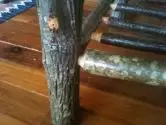Head, Heart and Hands

This was the philosophy that has guided the Arts & Crafts movement, from William Morris and Elbert Hubbard to Gustav Stickley and William Grueby.
And it still guides us today.
Our Heads are often stimulated through the many Arts & Crafts related books, magazines, lectures and conferences we are fortunate to have available.
Our Hearts have demonstrated just how easy it is to fall in love with the graceful curves of a matte green vase, the dimpled surface of a worn piece of copper or the bold, simple lines of a bookcase decorated with only pegged joints, exposed tenons or quartersawn flakes.
But our Hands?
After too many days of inactivity, I am drawn to my workshop where I invariably start a new project. Sometimes its little more than re-waxing a small tabouret or re-gluing a loose chair stretcher, but this time it was a larger project: building a rustic library table.
I started with the realization that I am not a furniture designer, so I turned to several of the sales catalogs of turn-of-the-century furniture makers that have since been reprinted. I was looking for the perfect combination of form, proportion and dimensions, so I included in my research both rustic and mainstream Arts & Crafts furniture. It did not take long, and so, once armed with the proper height, width and depth, I sketched out my table.
I was fortunate to have a hillside bristling with hardwood trees — hundreds of young, straight saplings, often three or more growing out of a single, old stump and in need of a careful thinning.
(In 1912, as the workmen were preparing to start construction on the granite Grove Park Inn, the architect advised, “Gather as many rocks and boulders as you think you will need — then double that amount.” The same can be said of saplings, and the extra ones can be saved, used as garden stakes or dried for burning in your fireplace or wood stove.)
Critical to making any rustic project both easy and fun is an inexpensive tenon-cutter. Mounted on the end of a hand drill, it acts like a pencil sharpener, quickly cutting a smooth and uniform round tenon that will slide into the corresponding hole drilled in the receiving leg. If you still cannot visualize it, simply Google it and you’ll find dozens of photographs.
I opted for a smooth, bird’s eye maple top, which I was able to cut and glue up in my workshop. If you don’t have a table saw and jointer, however, one of your local woodworkers will gladly cut and glue the top for a reasonable fee. Besides, the best part of this project is cutting and assembling the rustic base, which you can do with a handsaw, hand drill and tenon-cutter attachment.
Each of the joints should be glued and clamped. Drilling and tapping in small hardwood pegs is also an option, both as a structural and decorative feature. Don’t worry about not having an inventory of large clamps, as they don’t always cling well to round legs. Instead, create a tourniquet by looping a length of rope around each pair of legs, twisting it taunt using a short length of one of your saplings, then allowing it to dry and cure overnight.
The bark on the outside of your rustic furniture does not have to be finished, but some people prefer to be able to see a little reflective gloss just to make it a little less woodsy. Experiment on some scraps and decide for yourself.
My modest library table is by no means as sophisticated as most Arts & Crafts furniture, but it gives me a special pleasure each time I walk into the room.
Head, Heart and Hands.
It takes all three.

Until next Monday,
Have a great week!
Bruce
“We are as much as we see. Faith is sight and knowledge. The hands only serve the eyes.” – Henry David Thoreau
